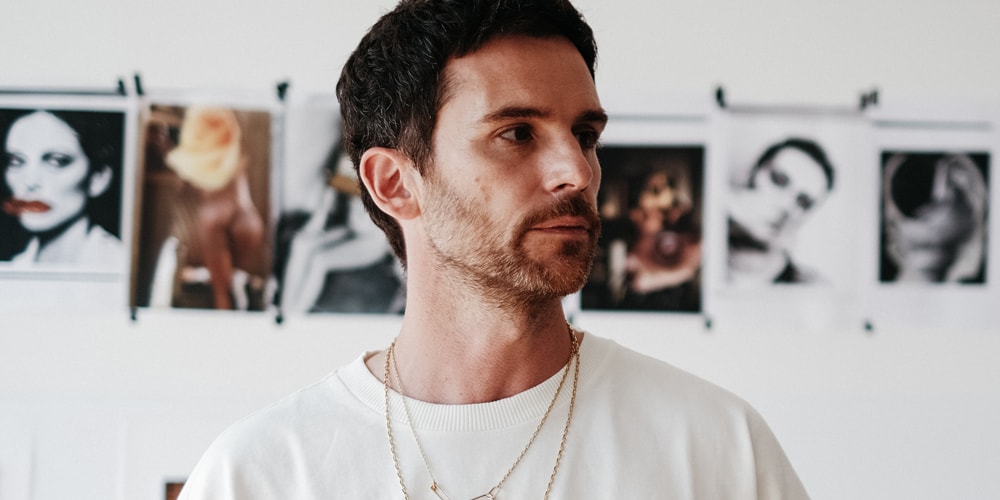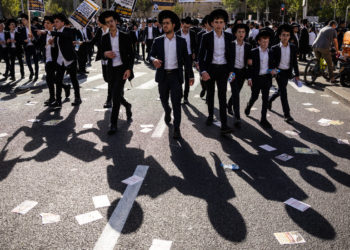If you look up the term applied art forms, you’ll find the definition: artistic disciplines that combine aesthetics and functionality, resulting in objects that are both visually appealing and useful. In the case of Guy Berryman’s label APPLIED ART FORMS, the discipline in focus is garment design and construction, with the outcome being a portfolio of collections that straddle modern practicality and utilitarian style.
This double-pronged approach to design – balancing form with function – has come more naturally to the Coldplay bassist-slash-creative director than some might expect. Upon launching the label in 2020, Berryman had already built up a personal archive of one-of-a-kind vintage finds, which he had sourced over years of touring with the band. Through delving into his wardrobe and experimenting with alternative cuts, Berryman now creates collections that showcase how the look and feel of vintage garments can exist in today’s fashion landscape, yet still age beautifully over time.
It’s taken time to get to this stage, but Berryman has paid close attention to every detail along the way. On a typical day, he can be found juggling hands-on tasks of conceptualizing collections and developing prototypes with his less preferred tasks of admin and paperwork. While he admits, “some elements are not what [he] imagined would be a part of [his] life in fashion, it’s become part and parcel of sustaining a fashion label in one of the most difficult industries.”
“I had become an avid collector of garments for around 15 years, and that archive started speaking to me as a library of ideas to create new things.”
What has made the journey worthwhile, however, is running APPLIED ART FORMS in the heart of Amsterdam. Having moved to the Dutch capital after living in the UK his whole life, the creative director made the choice to base the design studio there, saying, “It’s a very creative city where opportunities and collaborations are waiting to happen.” As well as its vibrant arts scene, it’s clear to see that Amsterdam’s distinct style codes have come to influence the label’s functional designs by weaving in a Dutch workwear edge.
Hypebeast catches up with Berryman as he dials in straight from his design studio, where the team is preparing for the label’s Paris Fashion Week showcase. Taking a short break from the chaos, he chats about his design processes, partnering with Audio Obscura on the Highway Rave event, and looking forward to the opening of the label’s first flagship store in Amsterdam.
Hypebeast: Can you explain what APPLIED ART FORMS is all about?
Berryman: It’s a brand that is largely inspired by my vintage archive. I’m kind of a super-nerd when it comes to collecting vintage, whether it’s utility clothing, military clothing, or workwear. The brand stems from that passion I have, channeled through modern silhouettes. In terms of style, my biggest influence is what I like to call “Japanese street style,” so lots of oversized, wide-bodied fits and generally loose-fitting clothes.
What inspired you to put your love for clothes into establishing a brand?
My background was in engineering and architecture before I was led down a different career path in music. I was interested in all kinds of industrial design and craftsmanship, and I thought I would end up designing chairs or lamps. But, I think I had gotten to a stage where I felt if I don’t do something in the field of design and manufacturing now, I’m never going to do it. By the point I’d made that decision, I had become an avid collector of garments for around 15 years, and that archive started speaking to me as a library of ideas to create new things.
Which fashion movements have influenced the brand? Are there any that you constantly revisit in your research?
For me, the primary source material is always original utility garments – mostly from the 1940s to the ‘50s and ‘60s. Everything was made very well back then, as soon as you get into the ‘80s and ‘90s, the quality started going down. I’m interested in the uniforms of the U.S Army, British Army, and British Navy – generally functional clothing, not from a style point of view, but more the level of craftsmanship. The process that I take when designing clothes is no different from that of other designers who I admire. Massimo Osti was one of the biggest collectors of vintage utility clothing, which informed everything he did with Stone Island and CP company. All of Helmut Lang’s inspiration came from Army surplus. Even Martin Margiela, the menswear is very different from the womenswear, with it being much more utility-focused.
“We’re not following seasonal trends or playing to trend forecasts. I think that’s a very dangerous game.”
How important is functionality in your designs?
I tend to avoid modern synthetic materials. For instance, a lot of our winter jackets will be made from a densely woven cotton, which isn’t necessarily going to keep you super dry if you’re walking out in a heavy downpour, but will have some water resistance. It’s a balancing act between understanding how certain materials age, but keeping in mind that they might not have a functional quality that modern-day fabrics have. A lot of the vintage garments I have look so great because they’re 70 years old and have got worn patches and random holes. Whenever we select materials, especially for outerwear, I think about what it’s going to look like in 70 years’ time.
As you split your time between the band and running APPLIED ART FORMS, have you felt inclined to bring the worlds of music and fashion together through the label?
At the moment, there isn’t a huge link. We did have a playlist link on the web shop, but I’ve always viewed music and fashion as two separate parts of my brain. I like doing this because making and wearing clothes is a very physical thing, whereas making music is something that you don’t touch, it’s something you feel and listen to. It’s a different process.
Saying that, we are opening our first flagship store in Amsterdam later this year. Being a music fan and also having a huge obsession with Japanese vinyl bars, my idea for the store is to make a space that engenders a community feel around the brand. It won’t be designed for somebody to just buy something and leave. It’ll be built around my passion for vinyl, soul music, jazz, and funk. Part of the store will have a listening bar that will invite people to come in and socialize or just have a coffee. You never know what ideas are going to be born out of bringing like-minded people together.
Why did you choose Amsterdam as the city to base your brand in?
I just fell in love with the city. I had been living in the English countryside for such a long time, and I wanted a new adventure. I found myself coming to Amsterdam quite a lot, and every time I was flying back home to the UK, I felt really sad leaving the city. I just kept thinking it was a magical place that has all of the culture you would associate with much larger cities – from the music scene to the art galleries and restaurants – but it’s wrapped up in this beautiful small city. It’s a UNESCO World Heritage site for a reason.
You recently partnered with Audio Obscura, making a limited-edition t-shirt for its Highway Rave event. How did it feel to be asked to be part of an event celebrating Amsterdam?
Well, when we were asked if we wanted to be involved in the event with Audio Obscura, they told us that they wanted to close down a highway and do this big rave. Big events in weird places are exactly what Audio Obscura is known for, so I was excited to be part of this one by making a T-shirt. In a way, the T-shirt designed itself. When you think about raves, the classic smiley comes to mind, and with this being a highway rave, I thought to incorporate a traffic sign in a sprayed-on effect. The run was limited to 750 T-shirts, and all the proceeds went to supporting the event.
Beside the event, what else have you got coming up for APPLIED ART FORMS?
Next week, we will be running a showroom at Paris Fashion Week Men’s, where we will be presenting our new collections to all of our buyers and taking them through the collection piece by piece. As always, the new range is all about timeless clothing – we’re not following seasonal trends or playing to trend forecasts. I think that’s a very dangerous game. So again, everything’s just based on me going through my archive, finding new things that I’ve been inspired by, and reinterpreting them in a modern way.
We’ve also started working on our first women’s collection, which will launch in Fall/Winter 2026. I was really nervous about it because I’ve always designed for myself. I wasn’t sure if I would be able to do it, but as I’m getting into it, I’m quickly realizing there’s so much more you can do in women’s than you can do in men’s. I’m a bit worried that what we’re doing in women’s is now stronger than what we’re doing in men’s.
To shop the latest collection from APPLIED ART FORMS, head to its website or partner retailers now.
The post Guy Berryman’s Love Affair With Vintage Is More Than an Obsession appeared first on Hypebeast.




